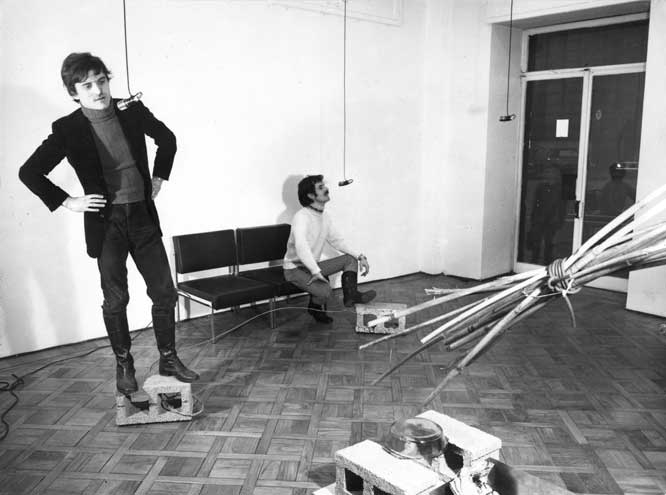‘My works are meant to be energy itself,’ said Gilberto Zorio in 1972, ‘because they are always living works, or they are works in progress, or works for the future.’ Since he emerged as a young artist from the Turin avant-garde during the late 1960s, Zorio has pursued the fusion of idea and form with remarkable consistency, using unconventional formats and often unlovely materials as means to explore what the critic Germano Celant described as ‘the precariousness of events, the “relativity of things” and the potential energy of the world’ to be transformed.
Although Zorio has been internationally recognised for several decades for work that has become part of the definition of Arte Povera, it is surprising that this one-man exhibition is his first in London and that his British solo debut occurred only five years ago, in Milton Keynes.
Comprising 12 works that span 45 years, the show effectively introduces the main threads of Zorio’s forward-thinking practice. Emblematic of the precursory position in subsequent conceptual developments that his experimental process has won him is Microfoni (Microphones, 1968), which is made up of several microphones suspended from the ceiling by cables: visitors can broadcast themselves while standing on concrete blocks placed unsteadily on ball bearings.
The significance of this work has not faded. Its primary material is sound, with the voice as catalyst, and neither is under the artist’s control. Thus the artwork only becomes active and meaningful once a spectator’s words reverberate in the surrounding space through an amplifier set to echo and distort whatever it receives. Because the effect is contingent on location and user, the outcome is always different. For that moment, and in the memory in which it lives, the environment is transformed, with the spectator becoming the performer within it.
This is one example of how Zorio takes hold of the connections and boundaries of the spaces in which he shows to generate sensations of fluidity and creative instability. On this occasion sound travelling down a cable from a microphone in the front area emerges from the loudspeaker in the rear gallery, a room dominated by a tall breezeblock structure. Movement around its perimeter seems obligatory and reveals the construction’s footprint to be a five-pointed star, the most recurrent of several emblems with dynamic cultural, historical and political associations applied by the artist throughout his career. The star’s interior is inaccessible except that through small gaps between bricks a glass alembic is visible, its liquid contents glowing yellow with diluted phosphorus and fluorescein.
The mechanical, mythical and chemical spheres repeatedly interrelate to unleash experiences involving light, heat and noise that engage multiple senses and not just the eye. When not actually kinetic, as in the sculptural assemblage Canoa Siviera (Canoe Ladle, 2013) periodically hissing and revolving overhead, installations arch tensely or assume elevated positions, like the projecting javelins and crucible in Compasso (Compass, 1980), which point with the concentrated force of a throw towards a future moment implied by the open space in front. At intervals the gallery lights switch off and sparks fizz from an upright metal star to illuminate momentarily streaks of phosphorus painted on the wall. As with nature, theatre is integral to Zorio’s expression; scale and surprise accentuate ephemeral ideas that, over time, get restaged and replayed with baroque restlessness.
More subtle, and highly eloquent of Zorio’s enduring themes, is Piombi II (Leads II, 1968). Two crudely shaped lead pans contain solutions: yellow copper sulphate in one and blue-green hydrochloric acid in the other. Copper wire hung from the ceiling connects these volatile elements and facilitates a reaction that causes coloured crystals to form, which eventually climb the cords. In its own time, the object will patiently make itself, at once a carefully constructed artwork and an organism undergoing unpredictable change.
Distinguished by the reciprocity of material, form and concept that inevitably challenges the viewer, this show at last supplies a London audience with a missing chapter in the sourcebook of how art’s contemporary practices emerged.
This review was first published in the October 2013 issue.
